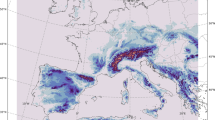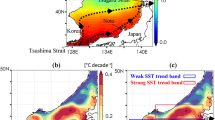Abstract
Wintertime cold air outbreaks along a non-frozen sea channel or a long lake can become destructive if the related bands of heavy snowfall hit onto land. The forcing for such bands is studied with a 2D numerical model set across an east–west sea channel at 60oN (‘Gulf of Finland’), varying the basic geostrophic wind V g. Without any V g opposite coastal land breezes emerge with convergence. This results in a quasi-steady rising motion w max ~ 7.5 cm/s at 600 m in the middle of the gulf, which can force a snow band. During weak V g, the rising motion is reduced but least so for winds from 60o to 80o (~ENE), when modest alongshore bands could exist near the downstream (Estonian) coast. During V g of 4–6 m/s from any direction, the land breezes and rising motions are reduced more effectively, so snow bands are not expected during moderate basic flow. In contrast, during a strong V g of 20–25 m/s from 110o to 120o (~ESE) the land breeze perturbations are intense with w max up to 15–18 cm/s. The induced alongshore bands of heavy snowfall are located in these cases at the sea but quite close to the downstream (Finnish) coast. They can suddenly make a landfall if the basic wind turns clockwise.








Similar content being viewed by others
References
Alestalo M, Savijärvi H (1985) Mesoscale circulations in a hydrostatic model: coastal convergence and orographic lifting. Tellus 37A:156–162
Atkinson BW (1981) Mesoscale atmospheric circulations. Academic Press, London
Bengtsson L (2000) Numerical studies of the energy and water cycle of the Baltic region. Final report, EU NEWBALTIC II (ENV4-CT97_0626), available from MPI-Hamburg, 203 pp
Brown RA (1972) On the inflection point instability of a stratified Ekman boundary layer. J Atmos Sci 29:851–859
Brümmer B (1997) Boundary layer mass, water and heat budgets in wintertime cold-air outbreaks from the arctic sea ice. Mon Wea Rev 125:1824–1837
Estoque M (1962) The sea breeze as a function of prevailing synoptic situation. J Atmos Sci 19:244–250
Gahmberg M, Savijärvi H, Leskinen M (2010) The influence of synoptic scale flow on sea breeze induced surface winds and calm zones. Tellus 62A:209–217
Hjelmfelt MR (1990) Numerical study of the influence of environmental conditions on lake-effect snowstorm on Lake Michigan. Mon Wea Rev 118:138–150
Laird NF, Walsh JE, Kristovich DR (2003) Model simulations examining the relationship of lake-effect morphology to lake shape, wind direction, and wind speed. Mon Wea Rev 131:2102–2111
Lin Y-L (2007) Mesoscale dynamics. Cambridge University Press, New York
Mazon J, Niemelä S, Pino D, Savijärvi H, Vihma T (2015) Snow bands over the Gulf of Finland in wintertime. Tellus A 67:25102. doi:10.3402/tellusa.v67.25102
Niemelä S (2012) Winter-time convection – heavy snowfall case in Southern Finland. HIRLAM Newsletter 59: 21–26
Niziol TA, Snyder WR, Waldstreicher JS (1995) Winter weather forecasting throughout the eastern United States. Part IV: lake-effect snow. Weather Forecast 10:61–77
Norris J, Vaughan G, Schultz DM (2013) Snowbands over the English Channel and Irish Sea during cold-air outbreaks. Q J R Meteorol Soc 139:1747–1761. doi:10.1002/qj.2079
Passarelli RE, Braham RR (1981) The role of the winter land breeze in the formation of Great Lake snowstorms. Bull Am Meteorol Soc 62:482–491
Pielke RA (2002) Mesoscale meteorological modelling, 2nd edn. Academic Press, San Diego
Savijärvi H (2011) Anti-heat island circulations and low-level jets on a sea gulf. Tellus 63A:1007–1013
Savijärvi H (2012) Cold air outbreaks over high-latitude sea gulfs. Tellus 64A:12244. doi:10.3402/tellusa.v64i0.12244
Savijärvi H (2014) High-resolution simulations of the night-time stable boundary layer over snow. Q J R Meteorol Soc 140:1121–1128. doi:10.1002/qj.2187
Savijärvi H, Alestalo M (1988) The sea breeze over a lake or gulf as the function of the prevailing flow. Beitr Phys Atmos 61:98–104
Savijärvi H, Niemelä S, Tisler P (2005) Coastal winds and low-level jets: simulations for sea gulfs. Q J R Meteorol Soc 131:625–637
Shirer HN (1986) On cloud street development in three dimensions. Contrib Atmos Phys 59:126–149
Wakimoto RM, Wilson JW (1989) Non-supercell tornadoes. Mon Wea Rev 117:1113–1140
Acknowledgements
H. Savijärvi is grateful to Sami Niemelä and Timo Vihma for the Fig. 1 material and fruitful discussions. The anonymous reviewers are thanked for their comments that improved the article.
Author information
Authors and Affiliations
Corresponding author
Additional information
Responsible Editor: J.-F. Miao.
Rights and permissions
About this article
Cite this article
Savijärvi, H. Cold air outbreaks along a non-frozen sea channel: effects of wind on snow bands. Meteorol Atmos Phys 127, 383–391 (2015). https://doi.org/10.1007/s00703-015-0370-8
Received:
Accepted:
Published:
Issue Date:
DOI: https://doi.org/10.1007/s00703-015-0370-8




